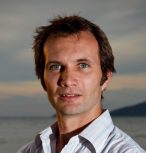DNA reveals the past and future of coral reefs
New DNA techniques are being used to understand how coral reacted to the end of the last ice age in order to better predict how they will cope with current changes to the climate. James Cook Univer

From 2005 to 2022, the main node of the ARC Centre of Excellence for Coral Reef Studies was headquartered at James Cook University in Townsville, Queensland (Australia)








Abstract. Spatial nutrients subsidies between ecosystems can be key to ecosystem structure and productivity. For example, seabirds feeding in the open ocean can deposit large quantities of nutrients onto islands when roosting or breeding, which may enhance plant biomass, and the demographics of island fauna. However, if these spatial nutrient inputs extend out to coral reef environments and how they influence the system is poorly understood. Here, we utilise a rare natural experiment, where some islands in the Chagos Archipelago are rat infested with few birds, while others are rat free with abundant bird colonies. This scenario translates to marked differences in nitrogen delivery to the islands. Using stable isotopes of Nitrogen, we show how islands with seabirds have a dramatically heavier nitrogen signature and abundance in soils and new growth leaves of coastal shrubs. While attenuating with distance from shore, these differences were apparent in halimeda and sponges on the reef flat, and in turf algae and damselfish (Plectroglyphidodon lacrymatus) muscle on the reef crest. The damselfish on reefs adjacent to the rat free islands were growing at faster rates compared to fish adjacent to rat infested islands. Reef fish communities adjacent to rat free islands had higher biomass of all feeding groups, with overall biomass 50% greater that rat infested islands. Collectively, this study demonstrates a spatial nutrient subsidy to the reef ecosystems adjacent to rat free islands, which enhance the productivity of the reef fish community. Invasive rats have disrupted this natural dynamic, highlighting rat eradication as a high priority for conservation in remote oceanic islands.
Biography. Nick is a Professor of Marine Ecology and Royal Society Research Fellow at the Lancaster Environment Centre, Lancaster University. He tackles large-scale ecological and social-ecological coral reef issues under the overarching themes of climate change, human use and resilience. He has assessed the impacts of climate induced coral bleaching on coral reef fish assemblages, fisheries and ecosystem stability. He has studied the patterns and processes by which degraded coral reefs recover, and how this can be influenced by management. He has worked extensively on the ecological ramifications of coral reef fisheries and various approaches to their management. Nick was a Research Fellow in the Centre from 2008-2015, and remains an Adjunct professor.
New DNA techniques are being used to understand how coral reacted to the end of the last ice age in order to better predict how they will cope with current changes to the climate. James Cook Univer
A new study on the effects of climate change in five tropical countries has found fisheries are in more trouble than agriculture, and poor people are in the most danger. Distinguished Profess
James Cook University researchers have found brightly coloured fish are becoming increasingly rare as coral declines, with the phenomenon likely to get worse in the future. Christopher Hemingson, a
Researchers working with stakeholders in the Great Barrier Reef region have come up with ideas on how groups responsible for looking after the reef can operate more effectively when the next bleaching
Abstract: As marine species adapt to climate change, their heat tolerance will likely be under strong selection. Individual variation in heat tolerance and its heritability underpin the potential fo
Abstract: The Reef Ecology Lab in KAUST’s Red Sea Research Center explores many aspects of movement ecology of marine organisms, ranging from adult migrations to intergenerational larval dispersal
Abstract: Macroalgal meadows are a prominent, yet often maligned component of the tropical seascape. Our work at Ningaloo reef in WA demonstrate that canopy forming macroalgae provide habitat for ad
Abstract: Sharks are generally perceived as strong and fearsome animals. With fossils dating back at least 420 million years, sharks are not only majestic top predators but they also outlived dinosa
Abstract: Connectivity plays a vital role in many ecosystems through its effects on fundamental ecological and evolutionary processes. Its consequences for populations and metapopulations have been
Abstract: Evolution of many eukaryotic organisms is affected by interactions with microbes. Microbial symbioses can ultimately reflect host’s diet, habitat range, and even body shape. However, how
Abstract: The past few years have seen unprecedented coral bleaching and mortality on the Great Barrier Reef (GBR) but the consequences of this on biodiversity are not yet known. This talk will expl